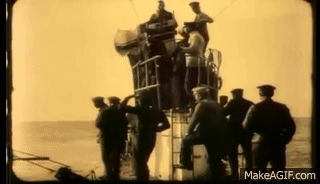 |
Left: Movie poster Der Magische Gürtel (1917). Right: Submarine commander Lothar von Arnauld de la Perière |
The Enchanted Circle (Germany, 1917)
Produced by the Bild- und Film Amt (BuFA), the film was approved by the German censor in August 1917 and subsequently screened in cinemas to wide acclaim. Ironically, the original German title Der Magische Gürtel is taken from a speech by Winston Churchill, First Lord of the Admiralty (1911-1915), who talked of liberating "our splendid Navy from the enchanted circle the [German] submarine has drawn around it."A camera team joined von Arnauld and his submarine crew for a five-week tour of the Mediterranean in the spring of 1917, filming events as 10 ships were sunk. All the footage was shot on deck, as apparently the cameras weren't sufficiently light-sensitive to film inside the submarine itself. There is strong emphasis on the proper treatment of the crews from the defeated vessels, which were only sunk once the crews were safely in lifeboats.
 |
Scene from Der Magische Gürtel (1917) |
In an interview after the war with Lowell Thomas for Raiders of the Deep (1928), von Arnauld described how the cameraman operated:
"It was on this voyage that we had a movie man along. Poor devil! His face still haunts me. Pea green it was most of the time. You see, he had never before gone to sea on a submarine, and he was a sufferer from mal de mer in its most virulent form. Usually he stuck to his camera crank as a real film hero should. Shells and bullets and oncoming torpedoes could not drive him from it. But sea sickness did. There were times when he longed for a shell to come along with his name written on it, to end it all. Then, when Neptune waved his wand and stilled the rolling deep, that cinema man was a hero once more. If we got into a rough-and-tumble gunfight with an armed ship he would take his own sweet time and would coolly refocus his magic box and switch lenses as though it were a hocus-pocus battle on location instead of grim reality."
The English would later use the movie as an anti-German film. A tinted version that fell into British hands formed the basis for the film's recent restoration by the Imperial War Museum. Unfortunately, this restored film version isn't available online at this moment.
After the war, the Americans also got hold of copies. Rowland V. Lee, a former actor at the Thomas Ince Studio, captured a film print at the American Occupation Headquarters in Coblenz. The footage was first distributed in segments in the Hearst newsreels in November 1919. The theatrical release of this American version - renamed The Log of the U 35 - was in January 1920. The Library of Congress and the National Archives in Washington, DC, hold the orginal footage. The National Archives have a viewing copy of this American version, as well as part of the original German film which can be watched online here. The Library of Congress has some nitrate on the film in several collections.
Here is a copy of the American revamp of this movie - The Log of the U-35- which has been uploaded on our YouTube channel.
No comments:
Post a Comment
Note: Only a member of this blog may post a comment.